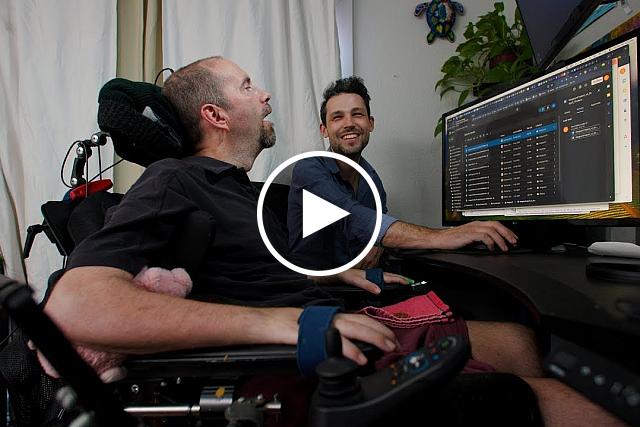You are here
September 10, 2024
Brain-computer interface helps paralyzed man speak
At a Glance
- Researchers developed a highly accurate brain-computer interface that allowed a man whose ability to speak was impaired by amyotrophic lateral sclerosis to communicate.
- Such devices could allow people with paralysis to converse with family and friends.

Brain-computer interfaces can help people with paralysis to communicate by decoding neural signals into words. Several such brain-computer interfaces have recently been developed. Previous interfaces have had limited accuracy, with around a quarter of words being incorrectly decoded. They also required an extensive calibration period before they could be used.
A team of researchers, led by Drs. Nicholas Card, Sergey Stavisky, and David Brandman at the University of California, Davis, developed a brain-computer interface to accurately decode speech from neural signals with relatively little calibration. They tested the system in a 45-year-old man with amyotrophic lateral sclerosis (ALS). He had been experiencing ALS symptoms for five years, could not walk, depended on others for activities of daily living, and had severely slurred speech. The study, which was funded in part by NIH, appeared in the New England Journal of Medicine on August 14, 2024.
The research team implanted four arrays of 64 microelectrodes each into the participant’s brain along the left precentral gyrus. This area of the cerebral cortex is involved in coordinating muscle movements related to speech. Neural activity recorded by these electrodes was decoded by external computers in real time as the participant attempted to speak, using an artificial neural network. A screen displayed the predicted words and read aloud using text-to-speech software. The voice of the system was designed to resemble the participant’s pre-ALS speaking voice.
The system was turned on 25 days after the electrodes were implanted. The team calibrated the system for 30 minutes while the participant attempted to speak prompted sentences with a 50-word vocabulary. The system decoded more than 99% of the words correctly.
On the second day of testing, the team did an additional hour and a half of calibration and expanded the system’s vocabulary to 125,000 words. The system decoded more than 90% of words correctly.
Over the next several months, the team continued to work with the participant to improve system performance. Within 16 hours of use, the system could decode about 97.5% of words correctly. It maintained this level of accuracy more than eight months after the electrodes were first implanted. The participant used the device in conversation for a total of 248 hours during the course of the study, speaking at a rate of about 32 words per minute.
“This technology is transformative because it provides hope for people who want to speak but can’t,” Brandman says. “I hope that technology like this speech brain-computer interface will help future patients speak with their family and friends.”
—by Brian Doctrow, Ph.D.
Related Links
- Research In Context: Movement After Paralysis
- How The Brain Produces Speech
- Scientists Translate Brain Activity into Music
- Brain Decoder Turns a Person’s Brain Activity into Words
- Device Allows Paralyzed Man to Communicate with Words
- System Turns Imagined Handwriting into Text
- Scientists Create Speech Using Brain Signals
- Voice, Speech, and Language
- The Brain Research Through Advancing Innovative Neurotechnologies® (BRAIN) Initiative
References: An Accurate and Rapidly Calibrating Speech Neuroprosthesis. Card NS, Wairagkar M, Iacobacci C, Hou X, Singer-Clark T, Willett FR, Kunz EM, Fan C, Vahdati Nia M, Deo DR, Srinivasan A, Choi EY, Glasser MF, Hochberg LR, Henderson JM, Shahlaie K, Stavisky SD, Brandman DM. N Engl J Med. 2024 Aug 15;391(7):609-618. doi: 10.1056/NEJMoa2314132. PMID: 39141853.
Funding: NIH’s National Institute on Deafness and Other Communication Disorders (NIDCD) and Office of the Director (OD); NIH’s Brain Research Through Advancing Innovative Neurotechnologies® (BRAIN) Initiative funded earlier phases of this research; US Department of Defense; A.P. Giannini Foundation; Simons Foundation; Searle Scholars Program; Burroughs Wellcome Fund; University of California, Davis; US Department of Veterans Affairs; Howard Hughes Medical Institute; Wu Tsai Neurosciences Institute at Stanford University.

